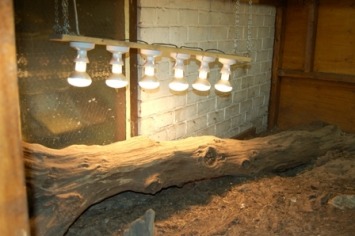Loading
HEATING LARGE ENCLOSURES
HOW TO GUIDE
How do you heat your large enclosures?"
I have been asked this question many times, in threads, PM's and in e-mails. This post will hopefully give you some ideas and help those of you who are struggling to maintain adequate temperatures in large enclosures. The following is how I do it and by no means the only way or the right way for every species. I currently heat two large enclosures in this way. The ones pictured are of a 12'x8'x5' enclosure used to house my pair of V.albigularis.
The first area I concentrate on is the basking site. This is the primary heat source for the whole enclosure. I use a bank of 6 60w R80 spot lights in this case (i remove two of the lights in the summer months as they are not required to achieve the required temps.) The fittings are mounted on a ply wood board and suspended by chain. This allows me to adjust the height of basking light until I have the desired surface temperature.
I have been asked this question many times, in threads, PM's and in e-mails. This post will hopefully give you some ideas and help those of you who are struggling to maintain adequate temperatures in large enclosures. The following is how I do it and by no means the only way or the right way for every species. I currently heat two large enclosures in this way. The ones pictured are of a 12'x8'x5' enclosure used to house my pair of V.albigularis.
The first area I concentrate on is the basking site. This is the primary heat source for the whole enclosure. I use a bank of 6 60w R80 spot lights in this case (i remove two of the lights in the summer months as they are not required to achieve the required temps.) The fittings are mounted on a ply wood board and suspended by chain. This allows me to adjust the height of basking light until I have the desired surface temperature.
It is very important to make sure that the basking area is of even temperature gradient and it must cover at least the snout to vent length of your animal. This will prevent the risk of thermal burns from a reptile only being able to heat part of its body.
The temperature is checked using an infra red temperature gun. These are vital tool for any reptile enthusiast and can be purchased off ebay for about £15-20.
For my albigularis I have a SURFACE temp at around the 140f (60c) mark. This will vary from species to species but is a good guide for most varanids.
This bank of light heats the entire enclosure for 12 hours a day. I achieve a thermal gradient from about 90-68f (32-20c) with this set up and they use every bit of it!
At night when the lights go out I have a secondary heat source in the form of two CHE's (Ceramic Heat Emitters) These are both 150w.
This bank of light heats the entire enclosure for 12 hours a day. I achieve a thermal gradient from about 90-68f (32-20c) with this set up and they use every bit of it!
At night when the lights go out I have a secondary heat source in the form of two CHE's (Ceramic Heat Emitters) These are both 150w.
These are controlled by a pulse proportional thermostat that I have set on the lowest temperature I want the enclosure to be, in this case 68f (20c.) I find that it is only on the coldest winter nights that these CHE's are actually ever on (as you can tell by the cobwebs on them!) This is due to the fact that the enclosure is fairly well insulated and hold the heat from the day very well.
I have tried a few thermostats and found the habistat ones to be the best. These can also be custom ordered with any length of probe you want which is really useful! (mine are 3m long ones so I can position the probes in the middle of the enclosure)
Rick can be found at http://www.reptileforums.co.uk/









